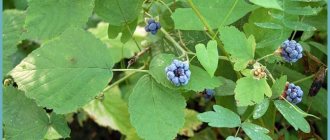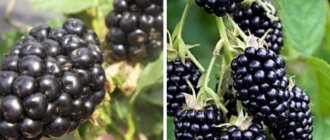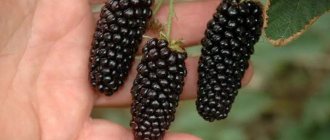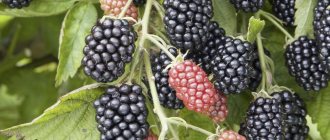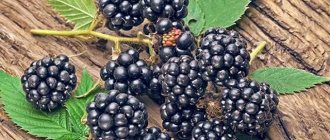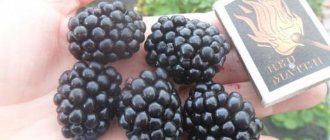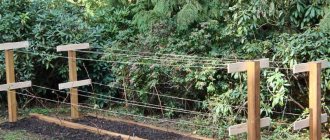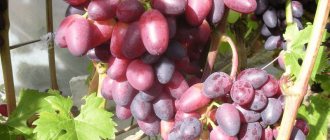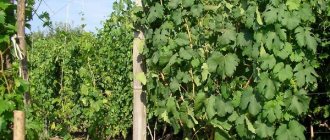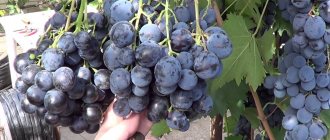History of selection
The varietal variety was bred in 2007 in France. As for the origins of the variety, despite the young age of the variety, they are unknown - the parent bushes were wild, but had excellent taste, thanks to which breeders paid attention to them and used them in laboratory breeding studies of the French nursery Marionette. As a result of these works, the Jumbo variety was introduced.
Botanical description
Jumbo is recognized by its powerful, non-spreading shoots that form a compact shrub. Among the characteristics of the shoots, it is worth noting the fact that until they reach 1.5 m in height they are erect, then they begin to slope down and even creep along the ground. Over the course of a year, the number of shoots increases by 2-3 pieces, and their length increases by 45–55 cm.
Did you know? An ancient Greek legend says that blackberries were formed from drops of blood that fell to the ground from the wounds of the titans, which they received in the battle with the gods.
Due to the weight of the fruit and the ability of the shoots to spread along the ground, they need a support (trellis) to which they are tied. The thornless shoots of the blackberry variety are covered with dark green foliage, which has an oval shape and a carved structure with jagged edges. Multiple veins are clearly visible on the foliage.
The juicy pulp is covered with a glossy, dense skin.
The color of the berries of the variety is black and shiny. Inside the juicy pulp there are small, non-hard seeds. As for the description of the berries, it is worth noting the large-fruited variety. According to this criterion, Jumbo is a leader and is qualitatively different from other blackberry varieties: this blackberry reaches a weight of 25–30 g. Externally, the fruits resemble raspberries and mulberries at the same time.
The taste of the berries is distinguished by their sweetness: the fruits contain 10–12% sugar. After consumption, a pleasant aftertaste is felt in the mouth, without sourness or bitterness. Important! The Jumbo variety is ideal for growing both for personal and industrial purposes.
Characteristic features of the Jumbo blackberry variety.
Blackberry Jumbo: photo of variety
Before planting this variety in your garden, weigh all the pros and cons to learn about its advantages and disadvantages.
The main advantages of the Jumbo variety.
The advantage of the variety lies not only in the excellent taste of the fruit, but also in its resistance to heat. It has excellent tolerance to elevated temperature conditions. The quality characteristics of the berries do not deteriorate; they are not capable of baking in the sun. The plant is unpretentious to the soil and is not afraid of the scorching rays of the sun. Lack of light does not have the slightest effect on the growth and development of the bush. But the shrub responds negatively to cold temperatures and high humidity, so it must be covered even in moderate climatic conditions.
When planting a plant in places located in the shade, it will need to be fed additionally.
How the Jumbo blackberry bears fruit.
Blackberry Jumbo: photo of variety
This variety is of medium ripeness. In the south, ripening begins on the fifteenth of July, and in the northern regions - on the first or fifteenth of August.
Since blackberries bear fruit for quite a long time, both flowers and fruits can be observed on the bush at the same time.
Productivity, fruiting period.
During the first year of growth and formation of the bush there will be no fruit. Don’t be upset, because next season the plant will give a generous, tasty harvest.
Jumbo blackberries bear fruit within 6 weeks. One bush produces twenty-five to thirty kg of fruit. Due to the undemanding nature of the variety, fruiting is possible under any conditions.
How are Jumbo blackberries used?
Blackberry fruits are eaten fresh, and they are also used to stuff pies. The berries are dried, dried, and made into jam, preserves, compote, marmalade, and jelly. Jumbo blackberries are also used in making wine.
Berries are frozen because they are able to retain their marketability and excellent taste, so housewives use the fruits fresh both in the summer and in the winter.
In addition, the plant acts as an antiseptic and works well against inflammation and in wound healing. Berries, leaves, and flowers have been used in alternative medicine. Decoctions and infusions are prepared from them.
Resistance to diseases and harmful insects.
There are a large number of different diseases in blackberry varieties, but the variety we are considering has high immunity to most of them, which is why it compares favorably with other blackberry forms.
There are also a small number of pests; if prevention is carried out in time, the risk of attacks from enemies will be reduced.
Advantages and disadvantages.
- Large size and weight of berries.
- The bush is compact.
- Excellent taste of the fruit.
- Decent yield indicator.
- Fruits for a long time.
- The berries are stored for a long time.
- Low maintenance requirements.
- Immunity to diseases.
- Without thorns.
- Resistance to hot periods.
Minuses.
- Reduced resistance to the winter season
Blackberry Jumbo: photo of variety
Characteristic
Among the key characteristics of Jumbo, it is worth noting resistance to temperature changes, productivity indicators and fruiting characteristics, pros and cons.
Drought resistance, frost resistance
The Jumbo bush withstands long periods of drought and is not afraid of rapid and stable temperature increases. The same cannot be said about frost resistance: the crop is afraid of frost, so it should be covered for the winter.
Productivity, fruiting
The Jumbo variety belongs to the mid-season, high-yielding species. In the first year after planting, do not expect that the young shrub will please you with a harvest: you will only be able to enjoy the berries the next season. The crop bears fruit in any conditions, the main thing is to provide it with the necessary care. The berries ripen in late July - mid-August, depending on environmental conditions. The fruiting period lasts on average one and a half months.
Important! Due to the long period of fruiting on one shrub, you can often see inflorescences, ovaries, and mature fruits at the same time.
The crop is distinguished by its stable, abundant fruiting: 20–30 kg of sweet berries, which ripen on large clusters, are collected annually from one bush.
Video: Jumbo blackberries
Advantages and disadvantages
- Jumbo blackberries have the following benefits:
- excellent taste characteristics of berries;
- large-fruited;
- long period of fruiting;
- high productive qualities;
- ease of harvesting, which is explained by erect, tied shoots;
- long-lasting shelf life of berries, and, accordingly, their good transportability;
- ease of agricultural technology: the crop is not picky and unpretentious in care;
- high levels of drought and heat resistance;
- good immunity: the plant is not afraid of attacks from most pests and diseases;
- the absence of thorns, which makes it easier to care for the bush and harvest;
- versatility of using berries.
Jumbo has virtually no disadvantages, except that this may include low frost resistance.
Blackberry Jumbo: reviews from gardeners about the variety
Maria Valentinovna Parkhomova, Belgorod region, 49 years old: “I have been growing blackberries for a long time, but previously there were only varieties with thorns in the garden. I was tired of the scratches, read reviews from gardeners with experience about the thornless variety of blackberries Jumbo, and decided to plant it. I bought two Jumbo blackberry seedlings, I can confidently say that the reviews are really true. The fruits are sweet, large, can be stored for a long time, and will not be wrinkled during transportation. The last fact is very important for my family, because we also sell Jumbo blackberries at the market, in addition to growing them for ourselves. I want to plant two more bushes this season. I also liked that Jumbo blackberries can be eaten for more than a month. I highly recommend you try it!”
Tatyana Aleksandrovna, Moscow region, 36 years old: “Jumbo blackberries without thorns were a curiosity for me. At first I was disappointed, the harvest in the first year was weak, but a friend saved the situation, explaining that it was necessary to prune the bush in a timely manner, since all its efforts were spent on growth. At that time we were just starting our “gardening careers”. We listened to the recommendations of a friend, and at that time blackberry varieties were already growing on her territory, they trimmed and fed the bush in a timely manner, and the harvest turned out to be excellent. The Jumbo blackberries are delicious, and the jam is to die for!”
Landing Features
One of the most crucial aspects of cultivating the described varietal variety is the correct observance of all planting features, about which read in more detail below.
Deadlines
The crop can be planted both in spring and autumn. Supporters of spring planting should wait until the soil layer warms up to a depth of 40 cm. If planting is carried out in the fall, then it should be done two weeks before the onset of cold weather and frosts.
Did you know? Blackberries got their name from the word “hedgehog,” since the thorny bush was associated with this particular animal.
Selecting a location
To plant a heat-loving plant, you should give preference to areas with good lighting: shaded conditions can negatively affect the yield of blackberries. The culture should be protected from cold winds and drafts, since it is classified as a heat-loving variety. The French hybrid painfully tolerates high humidity, so it is not recommended to plant it in low-lying wetlands.
It is better to plant blackberries on a slope or hill. The variety in question also does not welcome the close occurrence of groundwater to the upper soil layer - in such cases, gardeners advise taking care of good drainage. 3 weeks before planting, the blackberry plot is fertilized with a mixture of superphosphate (300 g), manure (4 buckets), soil (8 buckets), ash (700 g). This nutrient mixture is poured into each planting hole in a layer of 45 cm.
Pay attention to the information about what blackberries on the site are compatible with.
Selection and preparation of planting material
When choosing a Jumbo seedling, be guided by the following criteria:
- age: ideally, planting material should be one and a half to two years old;
- be sure to pay attention to the basal bud: if it is not there, discard such a specimen;
- healthy appearance of the root system: the roots should not show signs of disease or mechanical damage. There should also be 2-3 roots 10 cm long or more;
- the presence of 1-2 shoots on it;
Preparing seedlings for planting involves placing them in a solution of a biogrowth stimulator, for example, “Kornevin”. It is too difficult for Jumbo blackberry seedlings to acclimatize to new conditions: they may get sick and not grow, so they need proper care.
Planting scheme
Since the described variety forms a compact shrub, it can be planted more densely than other blackberry varieties. So, the standard planting scheme for the variety is as follows: between bushes you need to maintain a distance of 1 m. The distance between rows should be 1.5–2 m. It is permissible to plant even more densely.
Landing rules
There is nothing complicated about planting Jumbo blackberries. It is enough to follow simple rules.
Recommended timing
Jumbo is planted in spring or autumn. Bushes with a closed root system are planted from spring until the first frost.
Choosing a suitable location
Jumbo blackberries prefer sun and warmth, so it is best to plant them in areas with good lighting, protected from the wind, and preferably at a slight elevation. Excess moisture is harmful to the plant.
Soil preparation
When planting seedlings, you need to prepare a fertile mixture, which is laid out at the bottom of the dug hole. In order to make the mixture, the following components are needed:
- superphosphate – 300g;
- manure - 4 buckets;
- garden soil - 8 buckets;
- wood ash – 700 g.
The soil needs to be mixed well.
Selection and preparation of seedlings
The best age for planting blackberry seedlings is one and a half years. At the same time, they must have:
- 1-2 stems;
- presence of a basal bud;
- developed root system;
- 2 or 3 roots more than 10cm long.
Algorithm and landing scheme
The recommended seedling planting pattern for this variety is 1 m x 2 m. However, thickened plantings are allowed for Jumbo blackberries.
Subsequent care of the crop
Caring for Jumbo blackberries is quite simple and includes the following activities:
- watering;
- loosening the soil;
- seasonal and formative pruning;
- weed removal;
- feeding;
- preparation for winter.
Growing principles
Blackberries of the Jumbo variety need trellises for gartering, since grown shoots at a height of one and a half meters begin to bend towards the ground. And to prevent the formation of chaotic thickets, you need to take care of the plant.
Necessary activities
This variety tolerates drought well, but if possible, it is better to water the plant at least once or twice a week. It is imperative to water during flowering and fruiting.
To increase the yield of Jumbo, it is necessary to fertilize the blackberries in the spring. To do this, add 25 g of a nitrogen mixture and a couple of buckets of humus under the bushes. In summer, 45-55 g of potassium or phosphorus fertilizers are used for feeding for each bush.
Other agrotechnical measures (loosening and weeding) are carried out as necessary.
Shrub pruning
Proper pruning of blackberries promotes their growth and fruiting. The purpose of the spring pruning procedure is to rid the plant of frozen shoots. During the autumn season, aged, non-fruiting shoots are removed, which only weaken the plant.
Preparing for winter
When preparing Jumbo blackberries for winter, you need to cut off old and weak shoots at the root, leaving 7-9 young and strong shoots, which should also be shortened by a quarter (20-40 cm).
Having finished pruning, the bush is removed from the trellis and bent to the ground. The soil under the bush is covered with a layer of mulch of 10-12 cm. For this you can use sawdust, pine needles, and peat. The top is covered with agrofibre, film, or roofing felt.
Advice! Experienced gardeners correctly form the bush in the spring, directing young and fruiting blackberry shoots in different directions on the trellis.
Rules of care
Caring for Jumbo blackberries involves watering, loosening the soil around the bush, pruning, tying and shaping the bush, removing weeds, fertilizing and preparing for winter. So, if you don’t want blackberry thickets to start growing on your site, then take care of tying, pruning and shaping the bushes.
It is necessary to prune the bush in spring and autumn: in the spring, shoots that are frozen are removed, in the fall, old and non-fruit-bearing stems are removed.
After autumn pruning and shaping of the French hybrid bush, 6-7 young and healthy shoots should remain, which are shortened by 20–30 cm. Pruning is carried out at the root so that no stumps remain. The shoots are tied to special trellises, since shoots creeping along the ground complicate harvesting and can lead to damage.
Read on for information on the best way to feed blackberries.
Often a bush can become depressed, slow down its growth, not sprout new stems, and its yield sharply decreases, the berries become small and not juicy. Such symptoms indicate that your hybrid needs fertilizer. So, in the spring, the crop is fed with nitrogen mixtures (20–25 g of fertilizer for each bush) or humus (1–2 buckets for one bush). At the beginning of fruiting, blackberries are fertilized with potassium-phosphorus fertilizers (40–45 g per bush).
Despite the drought resistance of the selection variety, it needs watering, which must be done at least once a week. If there is a long period of drought, then the number of waterings should be increased to 2-3 times every 7 days. You need to pour 1-2 buckets of water under one plant (depending on the size of the bush). It is imperative to water blackberries when they bloom and bear fruit.
Mandatory maintenance procedures include loosening the soil and weeding around the bush. You need to loosen the soil after each watering, and remove weeds as necessary.
Blackberry Jumbo: planting and care
Blackberry Jumbo: photo of variety
Planting this blackberry plant is quite easy. You just need to follow the basic rules.
Optimal time to plant jumbo blackberries
Blackberries are planted in the spring or autumn seasons. Planting bushes with closed roots is carried out from the spring season until the onset of the first cold snap.
How to choose the right site.
The shrub likes to grow in a sunny and warm place, for this reason it is planted in well-lit spaces that are protected from the winds, and it is also better if it is a small hill. Excessive amount of liquid will harm the bush.
How to prepare the soil.
To plant plants, a nutrient substrate is prepared and laid out at the bottom of the planting hole. To prepare the soil mixture, three hundred grams of superphosphate, four buckets of manure, eight buckets of garden soil, and seven hundred grams of wood ash are mixed. All components are mixed well.
How to select and prepare Jumbo blackberry seedlings.
The optimal age for planting blackberry bushes is 1.5 years. Jumbo blackberry seedlings should have: one or two stems, a basal bud, developed roots, two or three ten-centimeter roots.
Planting scheme for Jumbo blackberries.
It is recommended to plant the bushes according to the 1x2 m pattern. But for this variety it is permissible to plant the plants densely.
Further agricultural technology.
This blackberry is quite easy to care for. It is necessary to water, loosen the soil, trim the bush, remove weeds, feed the bush and prepare it for the winter season.
Rules for caring for Jumbo blackberries.
Jumbo blackberries need to be tied to a trellis, because shoots that have grown up to one and a half meters begin to bend towards the ground. To prevent thickets from forming chaotically, you need to take care of the bush.
Required measures.
Blackberries of the Jumbo variety cope well with dry periods, however, if possible, it is advisable to water the bush 1-2 times every seven days. Be sure to water the plant when it blooms and bears fruit.
To increase productivity in the spring, the shrub is fed. For this purpose, twenty-five grams of nitrogen-containing fertilizer and two buckets of humus are applied using the root method. In the summer, the plant is fed with potassium or phosphorus (dosage - forty-five to fifty-five grams).
Loosen and weed the soil if necessary.
Jumbo blackberry pruning procedure
If you prune the bush correctly, it will grow, bear fruit and develop normally. The purpose of pruning a bush in the spring season is to get rid of frozen branches. In the fall, old shoots that do not bear fruit are removed, because they make the blackberry weak.
How to prepare Jumbo blackberries for the winter season.
When preparing the plant for the winter season, old and weak vines are cut off at the root, only seven to nine young and strong shoots are left, they are shortened by ¼ (twenty to forty cm).
After pruning is completed, the plant is removed from the supports and bent to the ground. The ground under the bush is mulched with a layer of ten to twelve cm. For this purpose, sawdust, pine needles, and peat are used. The mulch layer is covered with polyethylene, roofing felt, and agrofibre.
Gardeners with experience even in the spring season carry out competent formation of shrubs, namely, they direct young and fruit-bearing canes on different sides on trellises.
Harvesting and storage
Jumbo berries are harvested from mid-July to the end of August, depending on the environmental conditions where the plant is cultivated. Since the bush is tied to a support, it is quite comfortable to collect fruits. The task is simplified by the fact that the variety is thornless. Picking blackberries is easy: they do not wrinkle, are not damaged, do not leak juice, and retain a presentable presentation.
Did you know? Blackberries change several colors depending on the period of ripening: at the beginning they are green, then brown, then red-raspberry and finally black.
One of the significant advantages of Jumbo is the keeping quality of the berries: they can remain fresh for 7 days, and even more. But to do this they need to be placed in the refrigerator. This feature contributes to good transportability of the crop’s fruits over long distances. Frozen blackberries can be stored for a whole year.
Description of the variety Jumbo
The Jumbo variety has varietal qualities, for which it has become a favorite among amateur gardeners and manufacturing companies:
- The berries are similar to raspberries and mulberries at the same time. There are a huge number of fruits on the hands. The blackberry is large in size, which makes it one of the record holders among blackberry species. Jambo when fully ripe has a black tint, blackberry sheen and gloss. Moreover, one fruit of this variety reaches 30 grams in weight, and it is possible to collect up to thirty kilograms from one bush. The berries are elastic, dense, soft and with excellent juiciness; due to the skin, they are resistant to mechanical manipulation. The drupes are small in size, but have good rigidity. In addition, Jumbo has excellent transport and storage capabilities - the berries will last more than seven days if stored in the refrigerator. Ozhina is resistant to high temperatures and does not bake in direct sunlight.
- The shrubs are compact in size, yet strong. They grow without occupying large areas around them. The growth of shoots is directed mainly upward, with the stems adding 40 - 55 centimeters in length. Subsequently, they grow up to one and a half meters and bend down to the surface of the earth, which makes it necessary to organize support in the form of trellises. Throughout the year, the appearance of two or three young stems is observed. The variety is a representative of thornless hybrids. The foliage is dark green in color, the leaves are shaped like an oval, and have denticles.
- The plant does not tolerate high humidity and low temperatures, which is why it needs to organize shelters even in a temperate climate. And in conditions of shade or partial shade, there will be a need for additional fertilizing. The long ripening period (1.5 - 2 months) begins at the end of July or early to mid-August, depending on climatic conditions.
- Berries have a wide range of preparation options: eating fresh, creating a pie filling, drying, preparing confiture, compotes and others. In addition, it can be frozen.
The fruits of the berry bush are similar to the fruits of raspberries
Preparing for winter
Preparing blackberries for winter involves pruning, mulching the soil around the bush and covering it. How to trim a bush, read above. After pruning, you need to remove the stems from the trellis and press them to the ground, after mulching the soil with sawdust, pine needles or peat, hay, straw, dry leaves or even cut paper. Film, agrofibre or roofing felt are used as cover for shrubs.
Reproduction methods
There are two most popular methods of propagating Jumbo among gardeners:
- Cuttings. It is recommended to cut cuttings in the fall from well-wooded stems. The length of the cuttings should be 30–40 cm. The cut specimens are buried in moistened sand and sent to winter in a cool, dark place (usually a cellar). In the spring, planting material is dug up, the cuts are renewed and dug in again, while being covered with film to create a greenhouse effect. After 2–3 weeks, 2–3 young stems form on the cuttings. They need to be dug up, divided and grown in a school. Healthy young seedlings are transplanted to a permanent place.
- Rooting shoots without separating them from the mother bush. This method is carried out by bending a young annual stem to the ground and pressing it to the soil with special clamps. The shoot is tilted into a pre-dug trench, the depth of which is 15–20 cm. This rooting is carried out in August. Over the course of 30–50 days, the branch will sprout young shoots on which roots will already have formed. It is necessary to transplant such seedlings to a permanent site in early spring.
Diseases and pests
Jumbo has a weak immune system and, accordingly, he is susceptible to attacks from diseases and pests, including the following:
- Goitering of the root system , which is signaled by dirty swamp tumors that form on the root collar. The cure for this disease is a 1% solution of copper sulfate, which needs to be treated with the rhizome. It is also necessary to fertilize the crop with potassium, phosphorus and humus. For preventive purposes, it is recommended to loosen and weed the soil layer around the bush.
- Leaf curl. Symptoms of the disease are wrinkled and curled foliage, a change in its color (leaves become brown), and slower development of foliage. It is impossible to cure such a disease; it is necessary to remove diseased bushes. For preventative purposes, it is necessary to prevent the planting from becoming too dense; be sure to tie up the stems.
- Yellow mesh. The presence of the disease is indicated by bright yellow and light green spots on the foliage. The disease is caused by aphids, so if you find this small green pest, immediately treat the bushes with a solution of Confidor or Actellik. If your blackberry is sick with yellow net, then it is necessary to destroy the diseased bushes. Prevention of the disease involves checking for aphids in blackberries and purchasing planting material only from a trusted seller.
- Rust is a fungal disease that manifests itself in the covering of the foliage of a crop with spores (small pads, colored yellow or orange), the stems acquiring a brown color and the formation of a bright yellow or black coating on them. In order to eliminate the disease, you need to spray the bushes with “Kuproksat”, “Champion” or any other copper-based product. For prevention purposes, it is necessary to weed the weeds and prevent the planting from becoming too dense.
- Khrushchev is a pest that negatively affects the rhizome of the crop. To repel beetles, the roots of seedlings are soaked in Aktara solution (0.65%) before planting. Treating the soil and plants with “Antikhrushchev” and “Confidor” will help eliminate the pest. For preventative purposes, mustard is planted near the blackberry tree.
- The raspberry beetle is a pest that attacks all parts of the plant. To prevent its occurrence, the soil is sprinkled with ash and dug up for preventive purposes. The raspberry beetle is eliminated using the drugs “Kemifos”, “Iskra”, “Fufanon”.
- Blackberry mite , which provokes a deterioration in the condition of the bush and a decrease in yield. You should not expect large berries with such a pest. Both prevention and treatment of the crop consists of spraying the bushes with a solution of Tiovita or Envidora. For preventive purposes, plants are sprayed in the spring, for medicinal purposes - as needed.
- Spider mite , which causes blackberry leaves to yellow and fall prematurely. Treatment with a solution of Actovita, Fitoverma, BI-58 will help eliminate the pest. For prevention, loosening and weeding of the soil is carried out.
As you can see, with a little effort, you can grow an excellent variety of Jumbo blackberries in your own garden, the taste of which will not leave any gourmet indifferent, and any gardener will enjoy its relatively easy care.
Diseases and harmful insects to which Jumbo blackberries are susceptible
Jumbo blackberries can be affected by non-infectious diseases (due to excess or lack of microelements), bacterial diseases (root cancer), viral diseases (curl, mosaic, yellow netting, rust).
However, the blackberry variety we are considering has good immunity to diseases; if you follow preventive measures and agricultural practices, the shrub will produce an excellent, generous harvest for a long time.
Harmful insects .
- Khrushchev Damages the root system. Withering and death of the bush. How to fight: sow mustard next to blackberries; before planting, soak the roots in a solution of the Aktara preparation (0.65%); during the growing season, treat the tree trunk circle with “Confidor” and “Antikhrusch”.
- Raspberry beetle. Shoots, leaves, fruits, inflorescences, and root systems are damaged. How to fight: for prevention purposes, dig up the soil under the plants; dust the dug soil with ash or tobacco dust; When the buds appear, spray the bush with solutions of Iskra, Fufagon, and Kemifos.
- Raspberry stem fly . Young shoots are damaged. How to fight: cut off the affected shoots and then burn them.
- Blackberry mite. The appearance of the bush and the characteristics of the fruit become worse. How to fight: in the spring, spray the shoots (until the buds open) with Tiovit or Envidor solutions.
- Spider mite . The leaves turn yellow and fall off prematurely. How to fight: when the first leaves appear, the bush is treated three times every seven days with “Fitoverm”, “Aktofit”, “BI-58”.
Summary.
It is an obvious fact that the Jumbo blackberry variety, which has large fruits, has earned the attention and love of people involved in gardening. Someone might think that a foreign hybrid requires the most comfortable conditions, but in reality everything is completely different. The variety is undemanding, produces high yields, you need to put a minimum of effort into caring for it, so the shrub will also reward you with delicious berries.
Blackberry Jumbo: video about the variety
